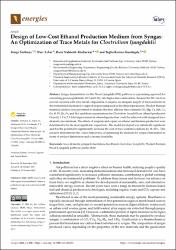Design of low-cost ethanol production medium from syngas: an optimization of trace metals for clostridium ljungdahlii

View/
Access
info:eu-repo/semantics/openAccessAttribution 3.0 United Stateshttp://creativecommons.org/licenses/by/3.0/us/Date
2021Metadata
Show full item recordAbstract
Syngas fermentation via the Wood-Ljungdahl (WL) pathway is a promising approach for converting gaseous pollutants (CO and CO2) into high-value commodities. Because the WL involves several enzymes with trace metal components, it requires an adequate supply of micronutrients in the fermentation medium for targeted bioprocessing such as bioethanol production. Plackett-Burman statistical analysis was performed to examine the most efficient trace elements (Ni, Mg, Ca, Mn, Co, Cu, B, W, Zn, Fe, and Mo) and their concentrations for Clostridium ljungdahlii on ethanol production. Overall, 1.5 to 2.5 fold improvement in ethanol production could be achieved with designed trace element concentrations. The effects of tungsten and copper on ethanol and biomass production were determined to be the most significant, respectively. The model developed was statistically significant and has the potential to significantly decrease the cost of trace element solutions by 18-22%. This research demonstrates the critical importance of optimizing the medium for syngas fermentation in terms of product distribution and economic feasibility.
Source
EnergiesVolume
14Issue
21Collections
The following license files are associated with this item:


















